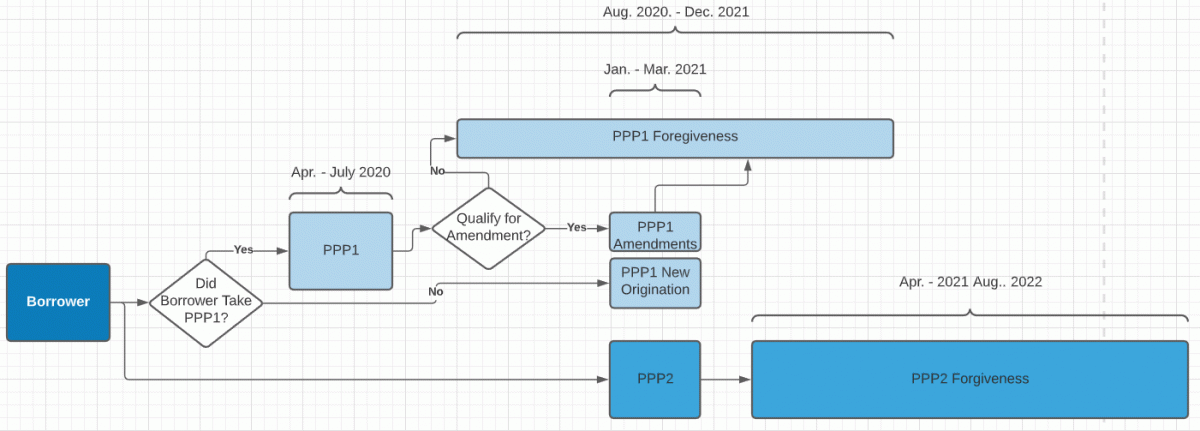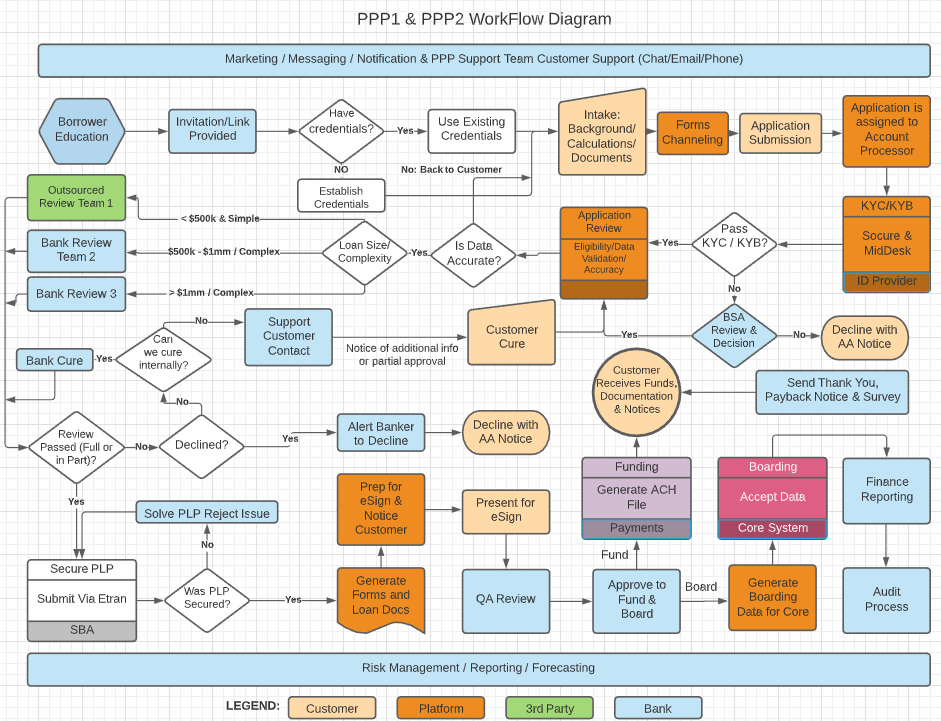Here Is a Process for PPP2 That Could Help You
Of all the lending programs in banking history, the Paycheck Protection Program (PPP) has to be one of the most complicated ever to enthrall bankers. Consider that in the next couple of weeks, banks will be: originating the second draw of PPP (PPP2) under new guidelines; originating PPP loans under the initial set of guidelines (PPP1) to include some amendments; amending PPP1 to accommodate larger amounts; forgiving PPP1 loans and setting up to forgive PPP2 loans. It is enough to make even the most organized banker’s head spin. In this article, we highlight our approach and a couple of lessons learned.
Getting Organized – Allocating Resources
While banks have known about another round of PPP (it has been in Congress since October), we were unsure of the timing and the number of resources to dedicate to the effort. While we discussed our planning earlier last month (HERE), now is the time to put the plan in action as the Program theoretically goes live in the next couple of weeks.
The critical consideration is where to focus resources. As mentioned, a lot is going on with PPP, and this is all in addition to our regular day jobs, including kicking off the year. Below is a timeline diagram of what we know now. Bankers will have to juggle four similar but distinct processes to assist the borrower during the first quarter. Then, bankers will also have to manage multiple forgiveness processes and the potential to handle two applications at a time. As of last week, a fifth process may also occur, which includes the return of EIDL advance funds that many banks withheld per SBA guidance only to have Congress reverse that decision.

Since bankers will not be able to staff each of these functions with separate teams, most banks will either need to outsource part of the customer support and underwriting/review functions or figure out a methodology for switching staff between all four processes. Some banks, for example, will switch all available resources to PPP2 for the first couple of months while PPP1 forgiveness goes on hold. This isn’t ideal, particularly when March is expected to be one of the largest forgiveness filing months. If borrowers go later than that, they risk having to deal with interest and potential principal payments (for banks that are amortizing principal).
Herein lies one of the most critical problems, shifting too many resources to PPP2 into March, and banks end up jeopardizing efficient forgiveness processing. The problem scenario would be that the bank would not be able to process a forgiveness application until the end of May (most banks are taking between 30 to 60 days to review an application, and the SBA would take an additional 90 days. This brings the timeline into August or Sept. before the SBA renders a decision. The borrower would have already made one or two payments. If this occurs, banks must take the time and resources to reverse those payments.
Banks will need to develop a set of metrics or a methodology on when to put staff on forgiveness and when to allocate more resources to PPP1 amendments or PPP2 origination.
Profitability, Efficiency & Getting the PPP2 Process Right
PPP1 generated about a 1.8% risk-adjusted return on average assets for banks. PPP2 looks to be slightly more profitable as banks have had time to refine their origination and forgiveness process to reduce cost. Specifically, leveraging the SBA’s Etran API, plus integrating identity verification, onboarding, e-signatures (instead of using a standalone process), and funding will be major improvements. In addition, some banks have automated underwriting to reduce the approval time by half.
These improvements, in addition to building a workflow that can leverage third-parties reviewers, can be seen in our sample workflow below.

Putting This Into Action
All banks need to proactively decide how to handle the reopening of PPP1 and PPP2. While we, along with our partner SmartBiz, offered our platform last month to all financial institutions, we are now at capacity except in cases where financial institutions project more than 3,000 borrowers.
Outside of that, banks can create their own platform, partner with some of the many other providers such as one of our favorites – Numerated or for banks that choose not to participate in the next round of PPP, SmartBiz offers an end-to-end digital solution to serve your customers. Customers will see a co-branded application page with your logo. Their PPP loan will be processed by SmartBiz and originated and serviced through a SmartBiz bank partner. You will be paid a fee to generate non-interest income and receive a daily report on how your customers progress with their PPP application.
If we can help in any way, either by recommending other partners or discussing processes, please let us know. In the coming week, we will be setting up a Teams/Slack/Hangout (haven’t decided which) workgroup for those banks interested in real-time discussions to help solve the invariable multi-stream of problems that are bound to arise.

